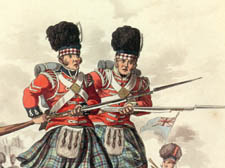|
|
 |
| |

92nd Highlanders during the Napoleonic Wars |
Stripped for action: Highlanders at war
Highbury author Tim Newark’s book uses diaries, letters and journals to tell the story of how Scottish ‘barbarians’ redefined battle, writes Peter Gruner
Highlander (The history of the legendary Highland soldier).
By Tim Newark. Constable £20.
THE war in Afghanistan is not the first time that a guerrilla force has fought a well-trained army with lethal effect.
Untrained 17th-century Scottish Highland rebels also used fearsome tactics when they were fighting in inhospitable terrain – the boggy windswept hills of Killiecrankie.
In his excellent new book, Highlander, historian Tim Newark describes how a red-coated army of Lowland Scots and English were virtually “frightened” into defeat by the appearance of a “mad” half-naked, fleet-footed brigade of Highlanders.
Indeed, Lowlanders, fighting on behalf of King William of Orange, with all their modern methods, were no match for the savage Jacobite Highlanders, who used an early form of “psychological” warfare.
Unlike the more genteel courtiers who commanded Lowland regiments and hung around the King, Highlanders were mainly poor, but tough, having to survive in a harsh and bitterly cold environment. However, with a reputation for fearlessness, they were described as rushing at the enemy like “wild boars”.
Highlanders fought with daggers, spears and handled Lochaber axes, and when it came to close combat they did not hesitate to throw off their tartan clothes and “offer their naked bellies to the point of a spear”.
The 3,000 Lowlander infantry and cavalry at Killiecrankie had been trained in the latest Anglo-Dutch technique of firing well-ordered musket volleys at the enemy. The Highlanders, on the other hand, were irregular fighters and expert in ambush – but ill-trained for an organised battle. Yet the Lowland commanders underestimated the value of the “bogeyman” factor. In the heat of battle, Highlanders would discard their belted plaid – the forerunner to the kilt – and charge at the enemy in their shirts, which, flapping in the wind, only just covered their groins.
Accounts of the battle described how the Highlanders advanced without shoes or stockings, covering themselves against the Lowlander fire with their shields. Finally, the hard men threw aside their muskets, drew broadswords and charged with “feral” aggression.
The Lowlanders fled down the hillside.
What characterised the battle was not training or skill, but fear. Most government soldiers were not killed in the initial clash but were mercilessly cut down in the chase.
The Lowland troops argued that their defeat occurred partly because many of their side were strangers to the Highlanders’ way of fighting. What’s more, the Highlanders were so quick to charge that the Lowlanders didn’t have time to plug bayonets into their muskets.
Newark writes that Killiecrankie was a terrible shock to those rulers who trusted in the potency of modern warfare. “Until that point, Highlanders had been dismissed by Scots and English governments as barbarians. At Killiecrankie, it can be said that the legend of the Highlander was born.”
The book follows the Highland warriors into the last Jacobite rebellion fought on English soil at the battle of Culloden in 1745.
The British army later employed Highlanders to fight in every corner of the world – from Waterloo, the deserts of Sudan and the mountains of Dargai, to the trenches of Flanders and the jungles of Burma.
Mr Newark, who lives in Highbury, tells their story through the words of the soldiers themselves, from diaries, letters and journals uncovered from archives.
At the Battle of Quebec in 1759, only a few years after their defeat at Culloden, the 78th Highlanders faced down the French guns and turned the battle. At Waterloo, Highlanders memorably fought alongside the Scots Greys against Napoleon’s feared Old Guard. In the Crimea, the thin red line stood firm against the charging Russian Hussars and saved the day at Balaclava.
Yet the story is also one of “betrayal”. Over the past decade the historic regiments have slowly been dismantled, despite widespread protest. Mr Newark, whose family were from Perthshire and were originally Highlanders, is scathing about the Labour government, which under Tony Blair was mainly responsible for bringing an end to the Highland regiments.
“After 250 years of proud history in the service of Britain, the Highland regiments were finally disbanded in 2006,” he said. “They have been reduced to the status of battalions within the new Royal Regiment of Scotland. It’s very sad.”
|
 |
|
|
 |
 |
|
 |
|


